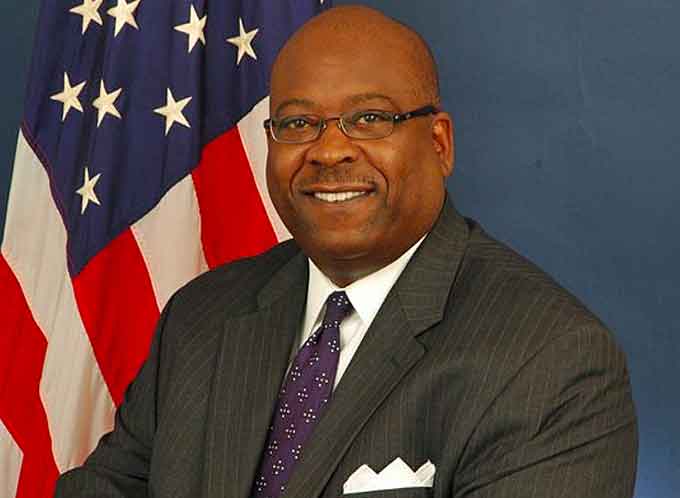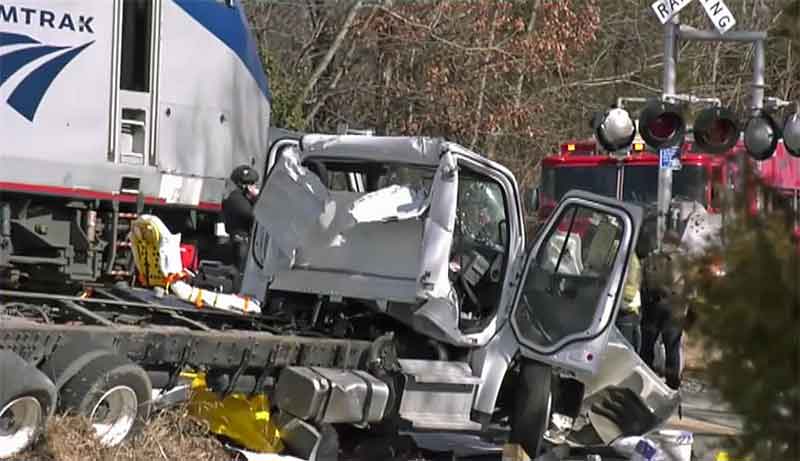
A number of high-profile passenger rail crashes have captured public attention recently. Although their circumstances may differ, the tragedies are a grim reminder that train safety belongs high on our list of transportation policy priorities.
A long-distance train from New York to Miami on February 4 crashed into a freight train on a siding, resulting in two fatalities and 116 injuries.
The train carrying a Congressional delegation to West Virginia on January 31 collided with a trash truck just west of Charlottesville, Virgina, causing one death and several injuries.
(An Amtrak train ended up on the wrong track and crashed into a freight train early Sunday morning in South Carolina, killing two employees and injuring 116 people. Courtesy of The National and YouTube. Posted on Feb 5, 2018)
On December 18, a train derailed between Seattle and Tacoma while moving at about 80 miles per hour (far exceeding the 30 mph limit), falling onto Interstate 5 below.
Three people died and about 70 more were injured.
According to the National Transportation Safety Board (NTSB), positive train control (PTC), a system that prevents train-to-train collisions, overspeed derailments, incursions into established work zone limits, and the movement of a train through a switch left in the wrong position, would have corrected for the overspeed crash in December (the same may be true for the crash in South Carolina).
Congress originally mandated that PTC be installed on all passenger and toxic cargo rail lines nationwide by the end of 2015, but that deadline was extended to the end of 2018.
It’s understandable why NTSB would highlight PTC as an expression of its frustration with delays in implementing this important safety technology. It’s been on NTSB’s Top Ten Most Wanted List for years.
(CNN goes inside the engineer’s cabin of a passenger train to learn how technology is used to prevent crashes and derailments. Courtesy of CNN and YouTube. Posted on May 14, 2015)
If Congress directed the implementation of PTC back in 2008, why hasn’t the technology been implemented yet?
How would PTC address underlying root causes of these recent deadly crashes?
The answer to these and other questions: it’s complicated. Here’s why.
Implementing PTC is a complex and costly endeavor.
PTC is not an off-the-shelf technology available at your nearest big-box store. And it’s about much more than just automatic braking.
A wide range of variables—speed, weight, length, geography, among others—influence how long it takes to stop a train, and the system must be able to account for all of them repeatedly and reliably, in all locations and operating conditions.

Moreover, PTC is not a single system, but a system of systems that must work seamlessly and interoperably.
For PTC to work, all of its different systems have to work together.
Given that the myriad private and public freight and passenger rail carriers in the United States operate independently, ensuring that compatibility is no small or simple task.
It’s also not an inexpensive task, with the nation’s private freight rail companies expecting to spend more than $10 billion collectively to fully outfit their locomotives and rail lines with computer hardware and sensors.
And that’s just the up-front costs; PTC will also drive higher operations and maintenance costs in future years. What we’re talking about is a massive investment, particularly for publicly funded commuter railroads.
Even if PTC would have prevented these crashes, other questions remain.
Why was the Washington train’s speed so much higher than the prescribed limit in the curve? Was it due to equipment malfunction, or issues related to the train’s engineer and conductor?

If it was the latter, was a lapse in judgment involved, or a distraction, or a matter of their familiarity with this new route?
Why was the switch in South Carolina locked to move trains into a siding, and did train dispatchers know the position of the switch as they directed the passenger train in this area?
PTC might have short-circuited these or other crash-causing problems, but knowing why the problems surfaced in the first place is just as important as circumventing them.
Railroad workers and auto drivers, being human, share something in common: both are fallible.
The big difference, of course, lies in the degree of the safety burden which they shoulder.
When an operator is responsible for a hundred lives or more, the margin for error is much narrower.
Implementing PTC requires cooperation by multiple agencies, and they’re not all alike.
Railroad operations are overseen by transportation agencies including the U.S. Department of Transportation, the Federal Railroad Administration, the Surface Transportation Board and the NTSB.
However, PTC systems also rely upon wireless communication capability between locomotives, the track system, and railroad back offices, and responsibility for licensing the (very limited) wireless spectrum lies within the Federal Communications Commission (FCC).

The Rail Safety Improvement Act of 2008 mandated PTC, but because the Act did not set aside dedicated radio frequency spectrum for the technology or direct the FCC to do so, the FCC has needed to assist the railroads in acquiring that spectrum from other licensees.
Private freight railroads have been able to buy the necessary wireless space, but cash-strapped public passenger carriers like Amtrak and local/regional commuter lines (which already must rely upon subsidies to operate) have a harder time finding money for those spectrum purchases.
It’s important to remember that Congress and federal agencies can be very different in how they approach their work.
Where safety is concerned, federal agencies tend to be more prescriptive, relying on regulations and enforcement to influence behavior.
In the case of wireless communications spectrum, however, the feds take a more market-based approach.
Congress mandated the implementation of PTC, but did not instruct the FCC to be more than a neutral party in how the implementation was to be carried out, and that makes the implementation more cumbersome.
We’re close, but we’re not there yet.
Two weeks after the crash in Washington, the Trump Administration signaled to the railroad companies that it plans to hold them to the current PTC deadline of December 2018.
If that’s going to happen (and if we’re to avoid yet another deadline extension) those operators will need more help, and some of that assistance should come in the form of the FCC and all other related agencies advancing the cause as active partners in improving rail safety nationwide.

In her message to the nation’s railroads, Transportation Secretary Elaine Chao spoke of a need “to help create an increased level of urgency to underscore the imperative of meeting existing expectations for rolling out this critical rail-safety technology.”
What Secretary Chao says is true; the need is urgent.
What’s also true is that these “existing expectations” of which she speaks should be shared by parties both inside and outside of government, in common purpose toward the achievement of this important goal.
The NTSB investigations into the causes of these three crashes will take months to complete. Still, it’s likely that one or more of these crashes could have been prevented by PTC.
Implementing PTC will constitute one of the most transformational advancements in the history of railroading, but it also represents an unprecedented challenge.
That’s why we shouldn’t overlook or shortchange the complicated factors that are involved in getting there.
This is not as simple as flipping a switch.
Gregory Winfree, J.D. is the Agency Director of the Texas A&M Transportation Institute and a former U.S. Assistant Secretary of Transportation.
Allan Rutter is a Senior Research Scientist at the Texas A&M Transportation Institute and a former Administrator of the Federal Railroad Administration.
The Texas A&M Transportation Institute (TTI) develops solutions to the opportunities and challenges facing all modes of transportation.
The Institute conducts over 700 research projects annually with over 200 sponsors at all levels of government and the private sector.
Recognized as one of the premier higher education-affiliated transportation research agencies in the nation, TTI’s research and development program has resulted in significant breakthroughs across all facets of the transportation system.
















